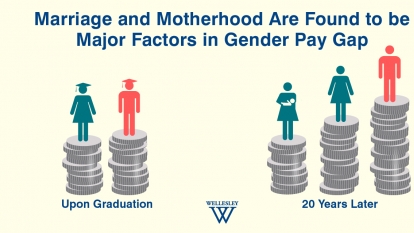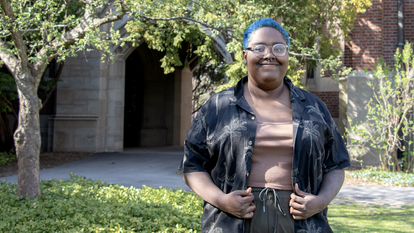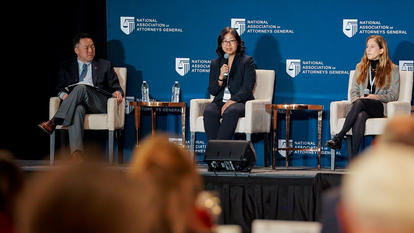Mother’s Day Amid a Pandemic: Three Wellesley Professors Explore Changing Motherhood

On this Mother’s Day, three members of Wellesley’s faculty—Brenna Wynn Greer, associate professor of history, Rosanna Hertz, Class of 1919–50th Reunion Professor of Sociology and Women’s and Gender Studies, and Olga Shurchkov, associate professor of economics—share their perspectives on changing representations and ideas of motherhood, in particular during the current COVID-19 pandemic.
How is the representation of motherhood changing in our society?
Brenna Greer: Representations of motherhood have changed in relation to the place children hold in our society. Coming out of World War II, the nation experienced a baby boom, as women across all socio-demographics were having two to three children in quick succession, with much encouragement. As the Cold War blossomed, the government, the media, and big business all promoted families as a stabilizing force, and Americans began having children for the sake of having children, when previously children had often been unplanned or considered a source of labor. At this moment we saw the rise of the “Susie Homemaker'” ideal of the stay-at-home wife and mother that FBI director J. Edgar Hoover valorized as the bulwark against “crime and Communism.”
Today, children hold a similar place in society, but mothers do not, with the great majority working outside the home. In my peer and professional circles, women typically have children with the plan that someone outside the family will help care for them as we pursue personal and professional goals. However, we are lacking the necessary shifts in gender expectations and child care systems to support women in today’s expansive idea of motherhood, which can cause harm to their health, relationships, and professions. The effects of this disparity reveal themselves in the constant discussion among professional women in my generation about our fatigue, frustrations, and failures as mothers. I routinely question and experience guilt over decisions that have taken me away from my daughter; my husband 100 percent does not. Now, as COVID-19 has me quarantined with my job and my family, I find myself wrestling with the realization of how much space I have—or don’t have—in my life for my child.
Rosanna Hertz: I am working on a series of cases around women who delay motherhood—after age 37. Two intertwined factors seem to be at work: More women, regardless of marital status, are postponing motherhood until their late 30s and 40s, and advances in reproductive technology are making it possible for these women to counter age-related infertility by conceiving with the use of an egg donor. New reproductive technologies have made it possible to divide motherhood not only into social and biological mothers but also in startling new ways, such as gestational, genetic, epigenetic, mitochondrial contributors.
In my new research published in March in the Journal of Family Issues, “Single Mothers as Bricoleurs: Crafting Embryos and Kin,” I look at single women whose last hope for biological motherhood is to conceive with an egg donor. I argue that as much as we culturally emphasize the genetic tie between mother and child, these women claim that gestational motherhood creates a bond between mother and child that is as precious as any other claim to motherhood. I explore this issue and also what women do and how they think about extra embryos—often a byproduct of IVF that is rarely discussed.
For a long time in the U.S. there have been cultural understandings of different kinds of motherhood. They include birth mothers, adoptive mothers, and even surrogates, and now we are seeing another expansion of ways in which women become mothers.
What impact is the COVID-19 pandemic having on mothers?
Olga Shurchkov: In my article on Medium (“Is COVID-19 turning back the clock on gender equality in academia?”) I write that almost overnight, my full-time job as an academic economist has become an afterthought: I now jot down research ideas between snack time and tantrums, read and write papers while I guiltily plug my kid into yet another device, and conduct Zoom meetings that are sometimes crashed by unexpected visitors. My recent research with collaborators, Tatyana Deryugina and Jenna Stearns, which was also covered by Bloomberg and the Economist, confirms that I am not alone. We find a large decrease in productivity of female academics in the months since the beginning of lockdowns (over 20 percent decline in April 2020 relative to the mean). Men, on the other hand, are submitting more papers and projects than women over the same timeframe.
“The full effects of the pandemic on gender gaps in the labor market will take time to emerge. The big outstanding question is whether these early disruptions to women’s work would make a difference in the long run.”
Olga Shurchkov, associate professor of economics
We hypothesize that one of main reasons for this widening of the gender gap in academia is that the burden of the disruption created by COVID-19 is being borne by women, especially by those with young children and no other child care options. For example, we know from previous research that male faculty are four times more likely to have a stay-at-home partner than female faculty (20 percent vs. 5 percent), and female faculty with children spend considerably more time engaging in caregiving activities compared to their male counterparts (35.5 vs. 20.3 hours per week).
The full effects of the pandemic on gender gaps in the labor market—my area of research focus—will take time to emerge. The big outstanding question is whether these early disruptions to women’s work would make a difference in the long run. But it seems that the effects can only amplify further, as women, especially those in the early stages of their careers, are being excluded from research opportunities. We are trying to collect data across a wide range of academic disciplines, as well as over time, in order to quantify these effects. Policymakers and higher education institutions should take notice of these alarming trends as they consider policies, such as offering widespread tenure clock extensions due to COVID-19, available to both male and female faculty regardless of their circumstances, and as they ponder equitable ways to distribute teaching burdens for the upcoming fall semester.
BG: It has been somewhat disorienting and unfamiliar to now be responsible for the day-to-day learning of my child with the closures of day care due to COVID-19. It makes me feel lacking in a lot of ways.
There are all these implicit messages about how our children are doing, what they should be doing, and how they should be doing it, and I have more concerns about my child’s development and social development in this new reality. And seeing the competition and concern among parents, it is hard for me not to project forward in terms of how the decisions I have made in my work life, and these particular circumstances, are going to bear on my daughter later in her life. We may, in many cases, be feeling inadequate, but that’s not true—we’re trying to do this whole other job at the same time.
I feel fortunate that my husband and I are both educators—precisely because of those cultural roles, and being a two-income family. In my circles, I see that the emails from school are being read by Mom, and it is more often the moms who are worrying more about their child’s social development or their homeschooling. And children are drawing on their moms more during this time. I hear of more instances of moms being interrupted in their Zoom calls than fathers. For me, in some ways, it blends my worlds, but it also disrupts. The dynamics are condensed right now.
What effect has the pandemic had on women’s decisions, or abilities, to pursue motherhood?
RH: Initially, the fertility industry shut down unevenly, clinic by clinic, because fertility—and women’s reproductive health more broadly—was not considered essential. Women who were undergoing fertility treatments were asked to wait. This shutdown was especially disheartening for older women who had delayed having a baby and had finally made the decision to start a family on their own. This has changed, and clinics are reopening, but one of the consequences of the pandemic is that banks and clinics are currently not recruiting or admitting new sperm or egg donors to their programs. The pandemic has already created longer wait times for appointments with medical personnel, and it is unclear whether there will be a scarcity in available donors or if new testing is needed medically.
OS: It might be too early to say anything for sure, but I doubt there will be a much-meme’d “coronavirus baby boom” as a result of lockdowns due to the pandemic. There is past research that shows that low-severity disasters lead to a positive effect on fertility, but high-severity ones (which, it is safe to say, COVID-19 represents) have a significant negative effect.
You might wonder—but what about World War II and the subsequent baby boom? The economy is the difference. By 1948, the unemployment rate in the U.S. had fallen to below 5 percent, and the economy was strong in the early 1950s. Now, on the other hand, the unemployment rate skyrocketed to 14.7 percent in April, the highest since the Great Depression, and there is no reason to expect the economy to recover quickly. Because of the financial uncertainties that many young people face as a result of the economic crisis, the decision to grow their families would likely be delayed.
Finally, and I speak from experience here, the sudden shock of child care options vanishing, and the uncertainty of when day care centers and schools will reopen and for how long, brings another important source of anxiety that might further deter people from having children, at least in the short term.



